

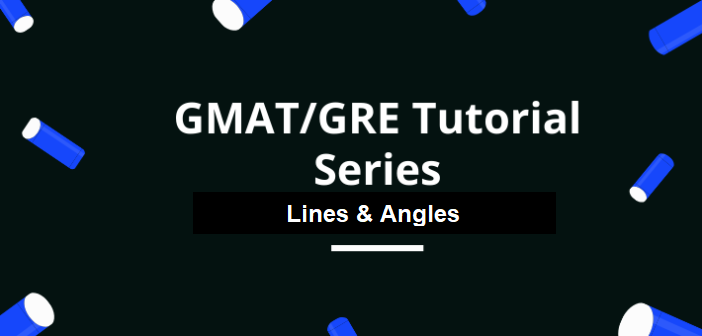
In this tutorial, the basic definitions and properties of lines and angles in geometry are covered. These concepts are frequently tested in many competitive entrance exams like GMAT, GRE, CAT, etc.
Line segment: A line segment is of a definite length and it has two endpoints

Line Segment
Ray: A ray has one endpoint and extends infinitely in one direction.
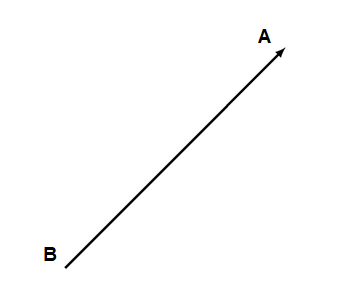
Ray
Straight-line: A straight line is of infinite length and it does not have a starting point or an endpoint.
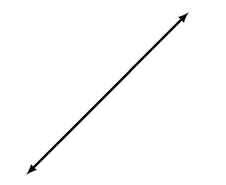
Straight Line
Acute angle: An angle between 0° and 90° is an acute angle, ∠A is an acute angle.
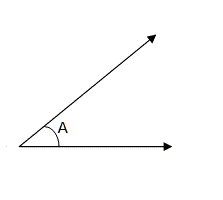
Acute Angle
Obtuse angle: An angle between 90° and 180° is an obtuse angle, ∠B, is an obtuse angle.
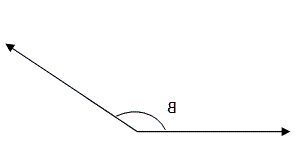
Obtuse Angle
Right angle: An angle that is at 90° is a Right angle, ∠A is a right angle.
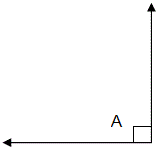
Right Angle Triangle
Straight angle: An angle that measures 180° is called a straight angle. ∠AOB in the figure below is a straight angle.
Also Check GMAT / GRE Tutorial Series Set Theory
Supplementary angles:
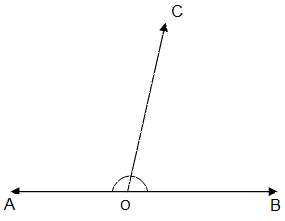
Supplementary-Angles
In the figure above, the sum of angles, ∠AOC + ∠COB = ∠AOB = 180°
When two angles add up to a total of 180°, these angles are called supplementary angles.
Two right angles always supplement each other.
A linear pair is a pair of adjacent angles whose sum is a straight angle or 180°.
Complementary angles:
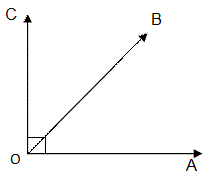
Complementary Angles
∠COB + ∠AOB = 90°
When two angles add up to 90° the two angles are called complementary angles.
Adjacent angles:
Adjacent angles are angles that have a common arm and a common vertex.
In the figure above, ∠BOA and ∠BOC are adjacent angles. Their common arm is OB and they meet at a common vertex ‘O’.
Vertically opposite angles:
The angles formed opposite to each other at the point of intersection (vertex) of two lines are called vertically opposite angles.
From the figure below,
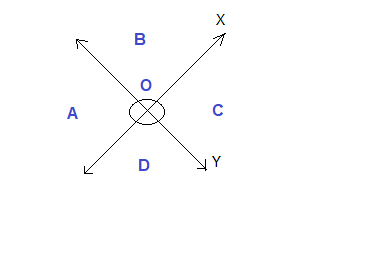
x and y are two intersecting lines.
∠A and ∠C make one pair of vertically opposite angles and
∠B and ∠D make another pair of vertically opposite angles.
Perpendicular lines: Two lines are said to be perpendicular to each other when an angle of 90° is formed between them.
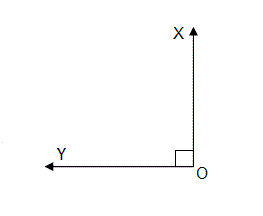
Here, the lines OX and OY are said to be perpendicular to each other.
Parallel lines:
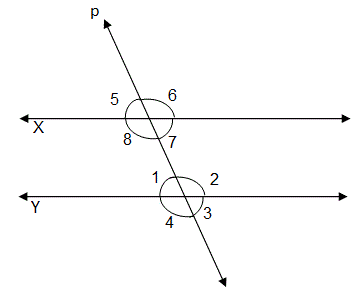
Here, X and Y are two parallel lines, intersected by a line p.
p is called a transversal, that intersects two or more lines (not necessarily parallel lines) at distinct points.
Also Check GMAT / GRE Tutorial Series Simple and Compound Interest
According to the figure above, 8 angles are formed when a transversal intersects two lines. Let us consider the details in a tabular form for easy understanding.
| Types of Angles | Angles |
| Interior Angles | ∠7, ∠8, ∠1, ∠2 |
| Exterior Angles | ∠5, ∠6, ∠3, ∠4 |
| Vertically opposite Angles | (∠1, ∠3), (∠2, ∠4), (∠5, ∠7), (∠6, ∠8) |
| Corresponding Angles | (∠1, ∠5), (∠2, ∠6), (∠3, ∠7), (∠4, ∠8) |
| Interior Alternate Angles | (∠1, ∠7), (∠2, ∠8) |
| Exterior Alternate Angles | (∠3, ∠5), (∠4, ∠6) |
| Interior Angles on the same side of transversal | (∠2, ∠7), (∠1, ∠8) |
When a transversal intersects two parallel lines,
Two lines are said to be parallel if they meet at least one of the conditions specified above.
Here are a few examples.
Solved examples
Example 1. If the lines m and n are parallel to each other, then find the values of angles ∠5 and ∠7.
Solution:
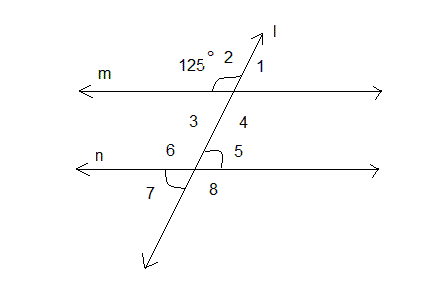
If we can find out one pair of angles, the remaining angles can be easily found out. Here is one of the many ways to solve this question.
∠2 = 125°
∠2 = ∠4 since they are vertically opposite angles.
Therefore, ∠4 = 125°
∠4 is one of the interior angles on the same side of the transversal.
Therefore, ∠4 + ∠5 = 180°
125 + ∠5 = 180 → ∠5 = 180 – 125 = 55°
∠5 = ∠7 since vertically opposite angles.
Therefore, ∠5 = ∠7 = 55°
Note: Sometimes, the parallel property of the lines may not be stated in the problem itself and the lines may seem to be parallel to each other; but they maybe not. It is important to verify the given lines on the basis of their angles and not on the basis of their looks.
Also Check GMAT / GRE Tutorial Series Triangles
Example 2. If ∠A = 120° and ∠H = 60°. Determine if the lines are parallel.
Solution:
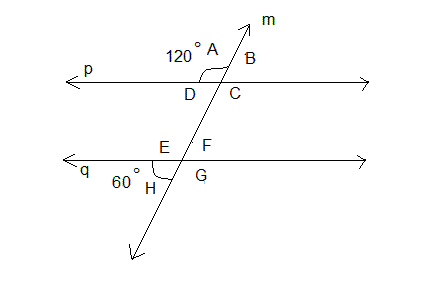
Given ∠A = 120° and ∠H = 60°.
Since adjacent angles are supplementary, ∠A + ∠B = 180°
120 + ∠B = 180 → ∠B = 60°.
It is given that ∠H = 60°. We can see that ∠B and ∠H are exterior alternate angles.
When exterior alternate angles are equal, the lines are parallel.
Hence the lines p and q are parallel.
We can verify this using other angles.
If ∠H = 60°, ∠E = 120° since those two are on a straight line, they are supplementary.
Now, ∠A = ∠E = 120°. ∠A and ∠E are corresponding angles.
When corresponding angles are equal, the lines are parallel.
Likewise, we can prove using other angles too.
Example 3. If p and q are two lines parallel to each other and ∠E = 50°, find all the angles in the figure below.
Solution:
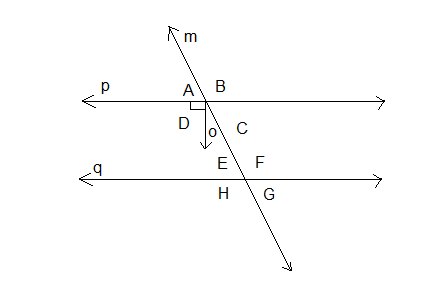
It is given ∠E = 50°.
The two lines are parallel
→ The corresponding angles are equal.
Since ∠E and ∠A are corresponding angles, ∠A = 50° .
→ The vertically opposite angles are equal.
Since ∠A and ∠C are vertically opposite to each other, ∠C = 50°.
Since ∠E and ∠G are vertically opposite to each other, ∠G = 50°.
→ The interior angles on the same side of the transversal are supplementary.
∠E + ∠D = 180° → 50 + ∠D = 180° → ∠D = 130°
→ ∠D and ∠B are vertically opposite angles. So ∠B = 130°.
→ ∠B and ∠F are corresponding angles. So ∠F = 130°.
→ ∠F and ∠H are vertically opposite angles. So ∠H = 130°.
∠D = ∠O + 90° → 130 = ∠O + 90 → ∠O = 40°
Also read: